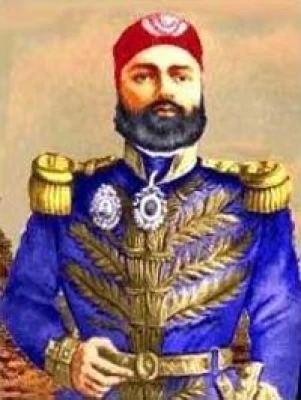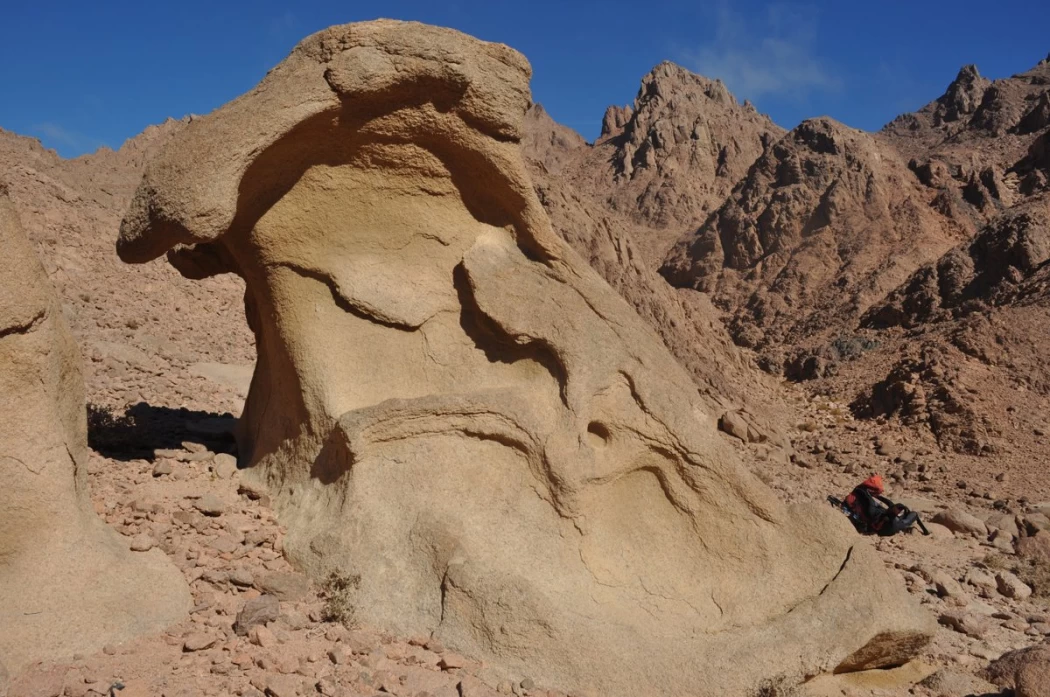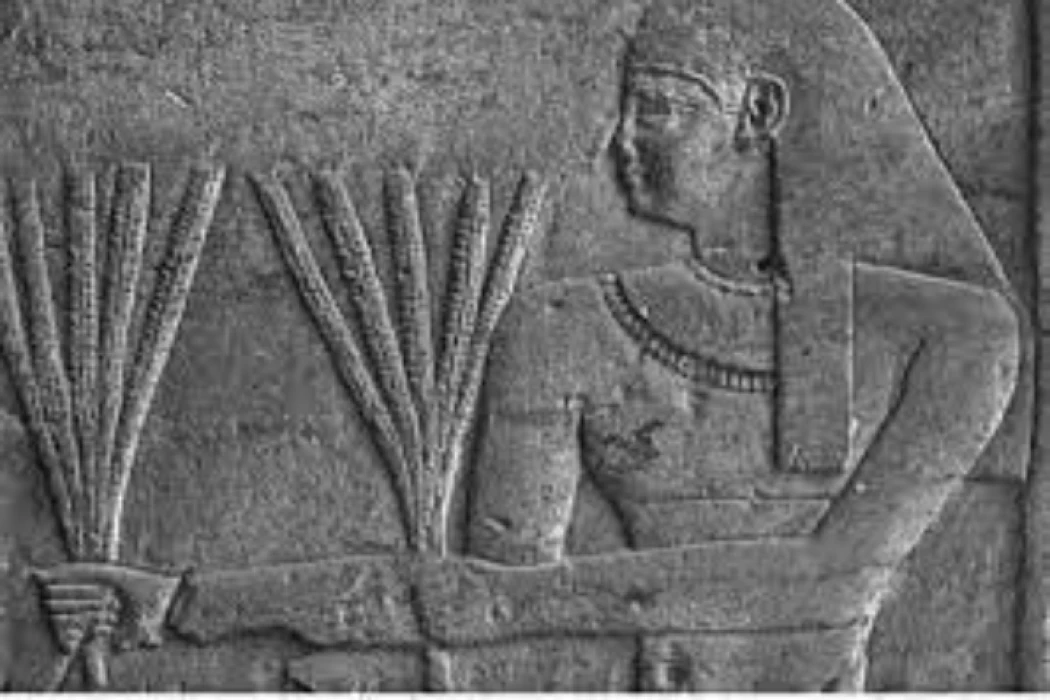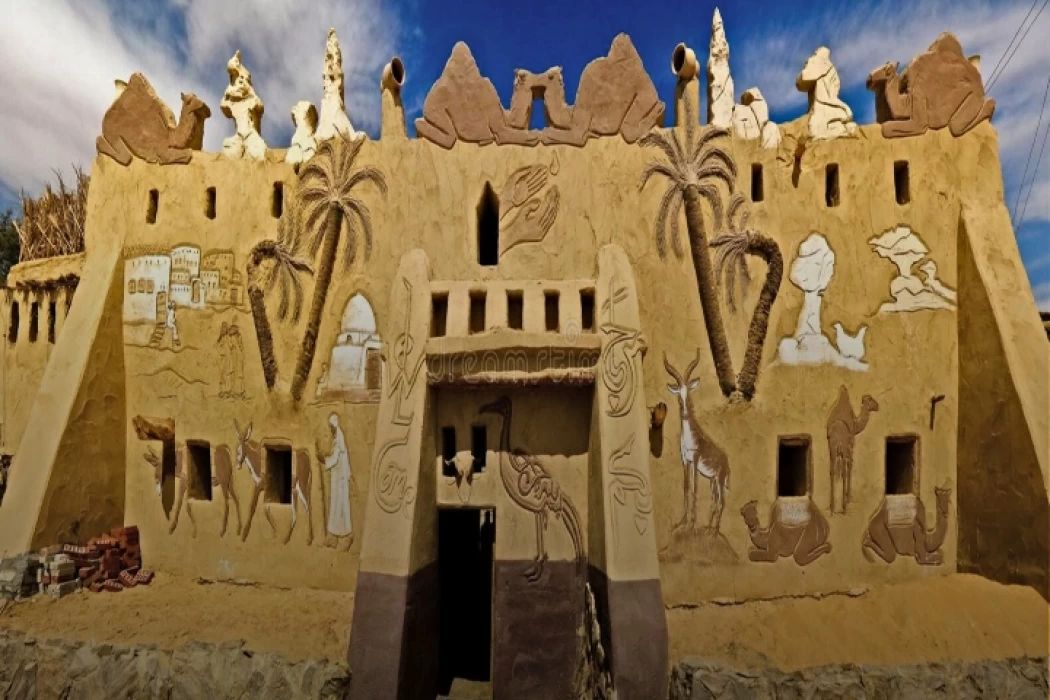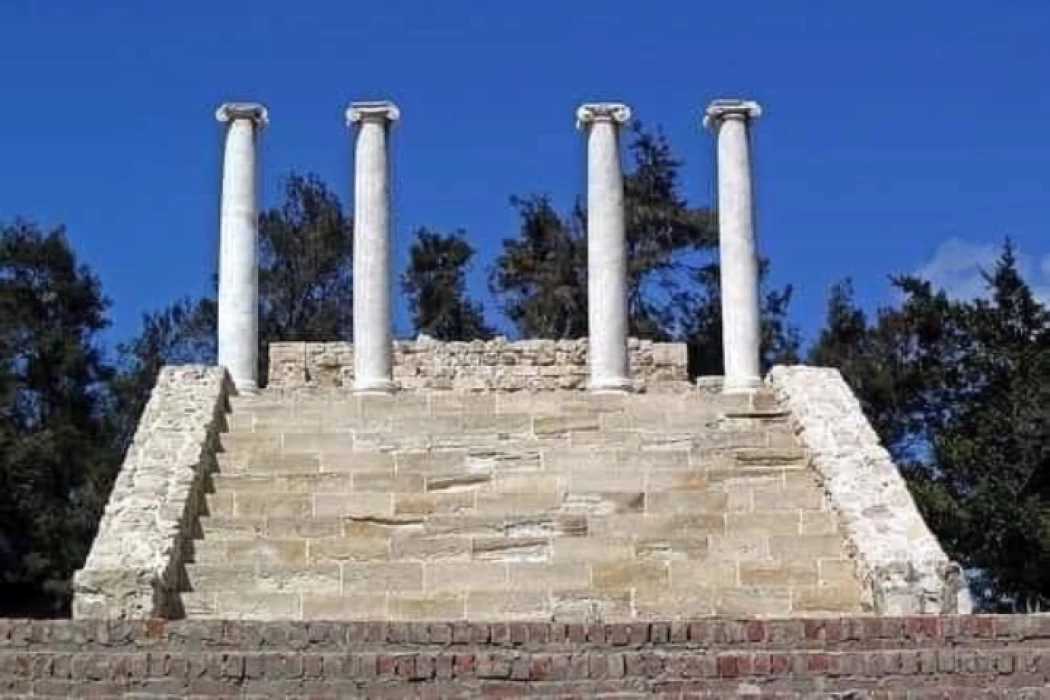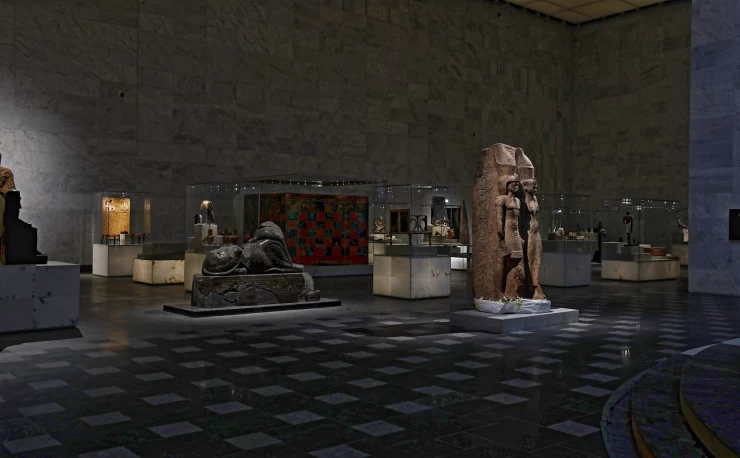
The king Userkaf
Userkaf (known in ancient Greek as ξὐσερόςρης, Usercherês) was one of the Pharaohs of ancient Egypt and the founder of the Fifth Dynasty. He ruled for seven to eight years in the early twenty-fifth century BC during the Old Kingdom era, probably descended from one of the branches of the royal family from the Fourth Dynasty. Although the name of his parentage is uncertain; it is more likely that he was the son of Queen khent Kaos. He had at least one daughter and probably a son named Sahu-RA by his consort Nefer hatbas and this son succeeded him in the reign.
Userkaf was probably one of the high priests of RA before his ascension to the throne where he built a temple of the sun known as the temple of nekhen-Ra located today between the villages of Abu sir and Abu ghrab in Egypt. In doing so, he established a tradition that was followed by his successors after him and for 80 years. The temple of nakhn-Ra was built to be a funerary temple for the worship of the sun at sunset. The rituals held in the temple were primarily concerned with the function of RA as the creator and his role as the father of the Pharaonic King. Considering the downsizing of the Royal funerary temple, this suggests that there is a more tangible separation between the function of the sun god and the king than in previous dynasties. After userkaf's death, his temple was rebuilt in four stages and a large obelisk was placed in it.
Userkaf built a pyramid in Saqqara close to Djoser's pyramid, the location of which forced the then architects to build the funerary temple associated with the pyramid in an unusual position somewhere south of the pyramid. In addition to his pyramid and Temple, userkaf built a smaller pyramid nearby for one of his Queens, most likely queen Nefer Hatab. And although userkaf was revered in posthumous funeral rites like other kings of the Fifth Dynasty, he was relatively unimportant, and his worship and veneration were abandoned after the end of the Fifth Dynasty era.
Little is known about his activities other than his construction of the pyramid and the temple of the sun. The royal chronicles of the Old Kingdom record that he made offerings of beer, bread and land to various gods, some of these offerings correspond to construction projects carried As for Beyond the borders of Egypt, it is believed that he made a military expedition to Canaan or the eastern desert, and trade communication with the Aegean civilization seems to have been active at that time.
Family
Nicholas Grimal believes that her husband may be the (priest of RA, Lord of sakhbo) mentioned in the Westcar papyrus. scientists Aidan Dodson and Diane Hilton suggest that Queen neferhotep was buried in a Pyramid adjacent to the one where userkaf was buried, as this pyramid is believed to belong to a woman of the same name.
However, the location of the pyramid attributed to neferhotep strongly suggests that she may have been userkaf's wife rather than his mother. If this hypothesis is correct, then Nefer hatbas in this case would be the mother of Sahu-ra, who succeeded userkaf in the reign. an inscription was found in which King Sahu-Ra appears next to his wife the Queen and his mother, who was identified as Nefer hatbas, which again confirms that she is most likely the wife of userkaf.the scientist yaromir Malik supports the earlier conclusion of Nicholas Grimal that neferhotep is the daughter of King djedev Ra and Queen hatep Haras considering the validity of this hypothesis, the American Egyptologist Mark Lehner supported the idea that userkaf's mother may have betrayed Kaos, the same idea supported by the scientist Ariel Kozlov.
While Aidan Dodson and Diane Hilton argued that neferhotep was not given the title of King's wife in later documents related to the funerary cult, and noted the lack of a convincing reason for this, they also suggested that the wife (consort) of userkaf may have been khent Kaos I, a hypothesis supported by the Egyptian historian Selim Hassan. scholars Clayton, Rosalie and Anthony David agree that khent Kaos I was the daughter of King Menkaure. scientist Bernhard gradsilov argued that userkaf as a descendant of Pharaoh djedev-Ra probably married a woman from the main royal dynasty-the line of Khafre and menqara - He was able to unite two rival factions within the royal family and end possible dynastic conflicts. alternatively, it is possible that userkaf was the high priest of RA before he ascended the throne, giving him enough influence to marry the widow of shepses Kaf who is believed to have betrayed Kaos I.
His children
Many Egyptologists believe that Sahu-Ra was the son of userkaf and not his brother as mentioned in the Westcar papyrus.confirming this is the finding of an inscription in which Sahu-Ra and his mother neferhotep
Period of Reign
Given the historical and archaeological evidence found the consensus among Egyptologists is that he reigned for seven to eight years at the beginning of the Fifth Dynasty of Egypt. the first evidence, a rough analysis of the royal records of the Old Kingdom, shows that the reign of userkaf was recorded in eight sections corresponding to at least seven full years, but not much more. the last readable year recorded in the records of userkaf is the year corresponding to the third livestock census, which was used in ancient Egypt to estimate the amount of taxes to be imposed on the population. It is believed that this significant event took place every two years during the period of the Old Kingdom, which means that the third livestock census marks the sixth year of his reign. The same conclusion was also reached when an inscription found on a stone from the temple of the sun built by userkaf was found. the second evidence is in the Turin papyrus (a document written during the reign of Ramesses II), which shows in the third column, row 17, that userkaf ruled for a period of seven years. the third evidence is the finding of very few small artifacts bearing the name of userkaf testifying to his short reign, these include an urn made of gold-plated diorite, a piece of stone weighing 5 Deben (an ancient Egyptian unit of weight measurement) and a stone cylinder seal found in elephantine, all of which today are on display at the Metropolitan Museum of art, as well as To an ivory cylinder seal preserved in the British Museum and another seal in the Bulaq Museum.
The only historical source that mentions that userkaf ruled for a long time is the book (history of Egypt) written in the III century BC during the reign of Ptolemy II (283-246 BC) by the historian maniton. No preserved copy of this damaged and lost book has reached US and is known today only through the writings of some later historians such as Julius africanus and Eusebius of Caesarea. The Byzantine scholar George syncellus has quoted Julius Africanus as saying that a book (history of Egypt) In particular, the order of kings mentioned by the historian maniton about the Kings of the Fifth Dynasty is consistent with that given in the king list of Abydos and the tablet of Saqqara, two lists of Kings written during the reigns of Seti I and Ramesses II, respectively.in contrast to the Turin papyrus, Julius Africanus estimates that userkaf reigned for 28 years a much longer duration than the modern consensus of historians.
Founder of the Fifth Dynasty
The historian maniton is considered to be the first to divide the ancient Egyptian kings into dynasties (families) and that in his lost book (history of Egypt), this division was intended to be as close as possible to the list of Greek rulers of Egypt in the Ptolemaic era. however, the prediction of the end of the Fourth Dynasty and the beginning of the Fifth Dynasty was probably noticed by the ancient Egyptians, who documented it as a narrative found by researchers in the Westcar papyrus.in this novel, King Khufu, a king of the Fourth Dynasty, predicted the demise of his dynasty and the rise of a new dynasty by the accession of three brothers of the Sons of RA to the throne of Egypt. This story dates back to the seventeenth dynasty or perhaps the Twelfth Dynasty.
Along with this historical evidence, the division between the fourth and fifth dynasties seems to reflect the actual changes that took place at that time especially in the Egyptian religion and in the role of the King. the preference of RA over the rest of the Egyptian gods, his reverence and worship more than others made him seem like a kingdom or family God, a ritual that did not exist during the reign of the fourth dynasty, which was more focused on royal burial rituals.
Userkaf's post before his ascension to the throne is not known. The historian Grimal mentions that userkaf may have been a high priest of the god Ra in the city of Heliopolis or sakhbo which are the center of the cult of RA mentioned in the westkar papyrus.Egyptologist Flinders Petrie proposed the hypothesis of a connection between the origins of the Fifth Dynasty and the city of sakhbo, noting that , According to the scientist petri, the assumption that the Westcar papyrus documented a tradition mentioning the origins of the Fifth Dynasty is possible to explain the division of the lists (families) drawn up by maniton, especially considering that there is no particular relationship between the elephantine and the Pharaohs of the Fifth Dynasty.
His activities in Egypt
Little is known about userkaf other than about his creation of his funerary temple and the temple of the sun. scholar yaromir Malik says that his short reign may indicate that he was very old when he became pharaoh. while the scientist Miroslav Werner considers the reign of userkaf important because it marks the peak of the sun cult and in it the Pharaonic title "Son of Ra" became regularly used from his reign onwards.
In Upper Egypt, userkaf either built or expanded the temple of the God Minto in Al-Tod where he found the first evidence proving the existence of userkaf. Due to the modifications made to the temple, especially during the early Middle Kingdom, New Kingdom and Ptolemaic eras, little remains of the original userkaf temple. There was a small mud-brick church with a granite column on which the name of the King was inscribed.
Further activities of userkaf can be inferred from the ancient state Chronicles, which were written during the reign of King Nefer-er-kar-Kakai or the reign of King ni-userkaf ra who recorded that userkaf made offerings to the gods of Heliopolis in the second and sixth years of his reign as well as to the gods of Putu in his sixth year. Also the chronicles mention the existence of a piece of land donated to Horus during the sixth year of userkaf's reign, this time explicitly mentioning the "construction of a temple [of Horus]".
Among the other gods honored by userkaf were the god Ra and the God Hathor, both of whom received gifts in the form of lands documented in the chronicles , as well as Nekhbet "gods of the divine Palace in Upper Egypt" and Wadjet "gods of the province of djebati" who received bread, beer and land as a kind of gift as well.a fragment of the text in The Chronicles suggests that the God Min may also have received gifts from userkaf. Further evidence of these religious activities taking place at that time was found in a royal decree in The Mastaba of the administrative official Nika Ankh buried at Tahna el-Gebel in central Egypt. userkaf, as mentioned in this decree, was making offerings or repairing temples in order to preserve the worship of the God Hathor, and he also installed "nikankh" as a priest for this worship.
Excavations of the pyramidal Temple of Amenemhat I in the village of alasht resulted in the finding of a stone fragment decorated with an inscription with the surname userkaf. This piece was reused as a building material. The inscription mentions the King's journey to the temple of Bastet in a ship called " Who controls the subjects While userkaf chose the village of Saqqara to build his pyramid complex, the officials of that time, including the vizier "Heti", continued to build their tombs in the Giza Necropolis.
Statues
Several scattered statues of userkaf were discovered, including a bust of the goddess Neith with features similar to those of userkaf and a figure found in his Solar Temple in Abu Sir, which is today in the Egyptian Museum. The statue is 45 cm (18 in) high and was carved from gray stone. This statue is of particular interest because it is one of the very few sculptures from the Old Kingdom era that shows userkaf wearing the red crown symbolizing Lower Egypt. The statue was discovered in 1957 during a joint excavation trip between the German and Swiss institutes in Cairo. There is another head statue believed to also belong to userkaf in which he is shown wearing the white crown symbolizing Upper Egypt and was made of colored limestone and is preserved today at the Cleveland Museum of art.
In 1928 the British scientist Cecil Mallaby Firth found in the courtyard of a temple located in the funerary temple of Saqqara the head of a huge statue of userkaf, which is today in the Egyptian Museum. This huge head was carved from Pink Aswan granite and shows userkaf wearing a pharaonic headdress with an image of a cobra snake on his forehead , it is the largest surviving head statue dating from the Old Kingdom and the only huge royal statue from this period other than the Sphinx of Giza.many pieces of userkaf statues were made of diorite, slate and granite but no limestone statue has been found at the same site.some pieces show userkaf's cartouches and the name of Horus.
Some scholars believe that these are good indicators of his age, as he may have ascended the throne as a teenager and died in his early twenties.
The sun Temple
Userkaf is considered the first pharaoh who built a temple dedicated to the sun god Ra in the Memphite necropolis north of Abu Sir,on a promontory located on the outskirts of the desert south of the modern Abu ghrab district. the works may have begun during the fifth or sixth year of userkaf's reign.the only plausible precedent for the temple of the sun at userkaf was the temple associated with the Sphinx of Giza, which was probably dedicated to RA and therefore and may have been used for similar purposes. in any case, the successors of userkaf during the next eighty years followed what he had started. the temples of the sun were built by all subsequent pharaohs from the Fifth Dynasty up to menkau-Hur-Kai , with the possible exception of shepses KARE who Perhaps his reign was too short to build one. it is not known why userkaf chose Abu sir as the site for his Sun Temple as the site had no special significance even in that period. the choice of userkaf may have influenced the later Fifth Dynasty kings who made Abu sir a royal tomb until the reign of menkau Hur Kai.
The Egyptologist Hans Goedecke considers userkaf's decision to build a sunset temple separate from his funerary temple to be a manifestation of, and a response to, the social and political tensions that most likely arose at the end of the Fourth Dynasty. the construction of the temple of the sun allowed to distinguish between the personal afterlife of the king and religious matters related to sunset, which were closely intertwined in the Giza pyramid complexes and in the Pharaohs of the Fourth Dynasty. thus, the pyramid of userkaf became isolated in Saqqara and was not even surrounded by a wider cemetery for the burial of his contemporaries, while the temple of the sun served the social need for sun worship which although represented by the king he would not exclusively embody. see some Scholars believe that the construction of the temples of the sun marks a shift from the royal cult, which was very prevalent during the early fourth dynasty, to the worship of the sun god Ra. The result of these changes was that the King came to be regarded with reverence and reverence as the son of the god Ra
Naming
The ancient Egyptians called The Sun Temple of userkaf the name nekhen-RA, which is translated in various meanings as" Castle of RA"," stronghold of RA"," dwelling of RA"," granaries of RA "and"hometown of RA". according to many Egyptologists, the name of the temple may refer to the city of Nakhon, also known as hierakonpolis. hierakonpolis was a stronghold and seat of power of the late Predynastic Kings who united Egypt. Scholars have also suggested that userkaf may have chosen this name to emphasize the victorious and unifying nature of the cult of RA or at least to show some symbolic meaning in relation to the monarchy. was also the name of an institution responsible for providing resources and wealth to the living King as well as his funerary cult after his death. as a result, the true meaning of nakhen-RA may be closer to "hierakonpolis Ra".
Career
The Solar Temple of userkaf first appeared in the list of pyramids by Karl Richard Lepsius in the middle of the XIX century and had the number seventeen. its real design was recognized by the scientist Ludwig Borchardt in the early twentieth century, while careful excavations began in 1954 and lasted until 1957 and were carried out by a team of scientists including "Hans stock","Werner Kaiser","Peter caploni","Wolfgang Helck" and"Herbert Reck".according to the royal chronicles, the construction of the temple began in the fifth year of userkaf's accession to the throne who on that occasion donated 24 pieces property for the maintenance of the temple The sun temple built by userkaf covers an area of 44 m × 83 m (144 ft × 272 ft) and was built towards the West. it was mainly a place of funerary worship of the god Ra and was supposed to be associated with the funerary cult of the King. structurally, the temple of the sun and the funerary temple of the King were very similar ,as they included a valley temple close to the Nile River and a passage leading to another temple located at a higher altitude on a desert plateau. Architecturally, they had a different design, for example, the valley temple of the temple of the sun does not turn towards any of the four main directions (east, west, north, south) but mysteriously turns towards the city of Heliopolis ,and its bridge (called the procession road) was not built adjacent to the axis of the elevated temple . The Abu Sir papyri, a collection of administrative documents dating from a later period of the Fifth Dynasty, indicate that the religious activities that took place in the temples of the sun and the funerary temples were related to each other. in fact, the purpose of the sun temples built during this period was to show the greatness of the god Ra and is the same purpose for which the pyramids were built for the King . There were funerary temples of the sun god, where it was believed that he could do rejuvenation, which was necessary for him to maintain his rule of the world. Thus, the rituals performed in the temple were primarily concerned with the function of RA as the creator in addition to his role as the father of the King. During his lifetime, the king would appoint his closest officials to administer the temple, allowing them to take advantage of the temple's financial resources and thus ensure their loyalty. After the death of the Pharaoh, the entrance to the temple of the sun became associated with the hermetic complex, both of which supported the funerary cult of the King.
Construction work on the temple of nekhen-Ra did not stop even after the death of userkaf and continued at least four stages of construction, the first of which may have occurred during the reign of Sahu-Ra [97], and then under the leadership of his successors Nefer-er-kar-Kakai and NI-userre-Ra. by the end of userkaf's reign, the temple of the sun did not have the large granite obelisk on a pedestal as it was supposed to. Instead, it seems that the main Temple consisted of a rectangular wall with a high mast mounted on a hill in the center of which probably symbolized the Falcon of the sun god. to the east of this mound there was a clay-brick altar with shrines and statues on both sides. according to the royal chronicles, since his sixth year on the throne userkaf ordered two bulls and two geese to be sacrificed daily in the temple of nakhn-Ra. these animals seem to have been slaughtered in or around the high temple, as the passage was wide enough for live Bulls to drive on it. in addition to these sacrifices, userkaf endowed his Sun Temple with vast agricultural lands of 34,655 acres (14,024 hectares) from the Earth, which the scientist Klaus Bayer described as "a colossal, unparalleled gift to the ancient kingdom". scientist Ariel Kozlov sees these decisions as a manifestation of userkaf's young age and the power of the priesthood of RA and not the result of his personal devotion to the sun god.
The hierarchical complex
Unlike most pharaohs of the Fourth Dynasty, userkaf built a modest pyramid in the north of Saqqara on the northeastern edge of the wall surrounding the Djoser pyramid complex.this (possibly political) decision may have to do with the return of the city of Memphis as the center of government ,since the west of the city was considered its Necropolis ,as well as userkaf's desire to rule according to the same principles and methods as Djoser.in particular, the funerary temple of userkaf is not surrounded by a cemetery for his followers, just like the funerary temple of Djoser, and unlike the pyramidal complexes in Giza. scientist Hans Goedecke argues that the wider religious role played by the pyramids of the Fourth Dynasty became It is now played by The Sun Temple while the King's funerary temple has come to serve only the personal funerary needs of the King. hence, userkaf's choice of Saqqara is an expression of manifestations of a return to the concept of "harmony and altruism" of the king that Djoser seemed to symbolize, as opposed to those represented by Khufu who personified the sun god almost personally.
Architecture
The userkaf pyramid complex is named after (Wap-ESOT) which means " the Immaculate places of userkaf "or"the pyramid of userkaf the holiest places".the height of the pyramid was originally 49 meters (161 ft) and the width of the base is 73.3 meters (240 ft). in terms of size, this pyramid is the second smallest pyramid after the pyramid of Unas, which was completed during the Fifth Dynasty. this small size of the pyramid compared to the pyramids of the previous Fourth Dynasty probably indicates that spiritual and financial resources were directed to the construction of the temples of the god Ra instead of being used in the construction of the huge pyramids for the burial of the King. the pyramid was built according to the techniques developed during the fourth dynasty using a heart made of stones Instead of using ruins that are irregular in shape and size as in the later pyramids of the fifth and sixth dynasties . The center of the pyramid was built very poorly, however, as soon as the outer shell consisting of fine limestone was stolen, the pyramid collapsed into a pile of rubble. the burial chamber was lined with large limestone blocks, and its roof was made of limestone gabled beams.
The funerary temple
The funerary temple of the userkaf pyramid is a bit strange in its design, it is located on the south side of the pyramid instead of the usual East Side. The reason for its construction in this form was undoubtedly due to the presence of the large moat surrounding the pyramid complex of Djoser and extending towards the East, or because of the general topography of Saqqara and the presence of the oldest tombs in the vicinity .In any case, this may mean that userkaf chose to be buried near Djoser, which means that userkaf could not use all the space of his temple. The German scientist Rainer Stadelmann believes that the reason for choosing the location and layout of the pyramid was practical and due to the presence of the administrative center of the necropolis in the north-eastern corner of the Djoser complex. Instead, the scientist Werner stated that userkaf wanted to take advantage of the religious significance of the Djoser complex by building his funerary temple nearby.
Userkaf's decision to locate the temple on the south side of the pyramid may have been motivated entirely by religious reasons, as Egyptologists Herbert Reck and Richard Wilkinson suggested that with this design the temple would be exposed to the sun throughout the year, while the German scientist Hartwig altenmuller suggested that the funerary temple was built adjacent to an obelisk that could have previously been found nearby.
The walls of the funerary temple are extensively decorated with bas-reliefs of exceptional quality . A few remnants of pigments were found on some of the inscriptions indicating that they were originally colored. The pyramid temple of userkaf represents an important innovation in this regard; he was the first Pharaoh to show scenes of nature in his funerary temple, including hunting scenes in the marshes that later became popular. The carvings are very detailed and there is one inscription showing at least seven different species of bird and a butterfly. The hunting scenes symbolized userkaf's victory over the forces of chaos, and thus may have explained userkaf's role as Eri-Maat, that is, "the one who believes in Maat", one of userkaf's nicknames.
Researchers were able to get to the funerary temple of userkaf from the Nile River by crossing to a valley temple connected to the funerary temple with a bridge (called the procession road). This valley temple is still today in the process of discovery and excavation .
The pyramid complex of Nefer hatbas
About 10 meters (33 ft) to the south of the mortuary temple of userkaf, there is a separate pyramid complex built, most likely, for one of his Queens. This pyramid built on the east-west axis is almost destroyed today and only a small pile of ruins remains of it . It is not known exactly to whom this pyramid belongs, however, many Egyptologists believe that it is for neferhotep to imprison the mother of Sahu-RA or the consort of userkaf.
The height of the pyramid was originally about 17 meters (56 ft) with a slope equal to 52 degrees similar to the pyramid of userkaf, and the length of its base is 26.25 meters (86.1 ft).the core of the main pyramid and the place of worship was built in the same technique, consisting of three horizontal layers of local limestone quarried rocks and gypsum mortar. the core of the pyramid was covered with an outer shell of soft limestone, which has been removed today. The pyramid was widely used as a quarry and even its inner chambers are exposed. These rooms are a miniature copy of those in the main Pyramid of userkaf, but they do not contain storage rooms.
The funerary temple
The Queen's pyramid complex had a separate mortuary temple located on the eastern side of the pyramid. The entrance to the temple leads to an open colonnaded courtyard running from East to West in which offerings are prepared and prepared . There is a sacrificial chapel adjacent to the side of the Pyramid, three niches, statues and a few warehouse rooms for storing offerings. the halls of the temple are decorated with carvings showing animal processions and sacrificial bearers heading towards the shrine of the Queen.
Legacy
Userkaf received a posthumous funerary cult like other pharaohs of the fourth and fifth dynasties . This cult was sponsored by the state and depended on the offering of offerings produced in dedicated agricultural areas established during his lifetime, as well as other resources such as fabrics brought from the "House of silver" (Treasury).
This cult flourished in the early to mid Fifth Dynasty, as evidenced by the tombs and seals of the priests and officials involved in it, such as (nikor) who served in the cult of userkaf and Nefer-re ; (nikankh and Khnum-hateb) who served in the hierarchical complex of userkaf ; (Ptah-hateb, a priest of the temple of nakhen-Ra and served in the mortuary temple of userkaf ; (tepmanakh, ninkhvetka, and sinuankh)who served in the worship of userkaf and Sahu-Ra ; (bahinukai) who was a minister during the reign of Sahu-ra and Nefer-er-kar-Kakai ; and finally (nikohor) who was a judge, inspector of the book, special adviser and priest of the funeral cults of userkaf and Nefer-Ra.
Middle Kingdom
The cult of userkaf was officially abandoned in the long term at the end of the Fifth Dynasty. by comparison, the official funerary cult of at least one of userkaf's successors, the King (ni-userre-Ra), probably lasted until the Middle Kingdom. by the Twelfth Dynasty The Mortuary Temple of userkaf was probably in ruins or dismantled, as stone tablets showing userkaf performing religious rituals were found and were reused as building materials in the pyramid of Amenemhat I. userkaf was not the only king whose funerary temple met this fate, the temple of NI userre Ra was also vandalized, although priests were serving in it at that Time . These facts indicate the demise of the Royal interest in the state-sponsored funeral cults of the rulers of the Old Kingdom In the cemetery of Saqqara, an inscription was found on the grave of the priest Miho, who lived during the Ramesside Period (1292-1189 BC), in which userkaf appears. Early in this period, during the reign of Ramesses II, Ramesses ' fourth son khaemwas (C.1280-1225 BC)ordered restoration work to the pyramid of userkaf, as well as to other pyramids dating back to the Fifth Dynasty. Inscriptions were found on the stone cladding of the userkaf pyramid showing khemwas with the sacrificers, which was considered evidence of the restoration of the userkaf pyramid.
The inscriptions were copied from the funerary temple of userkaf during the twenty-sixth dynasty in the late era. An inscription was also found showing userkaf wearing a round crown with ornate bands and a pharaonic link with what looks like the horns of the crown of Atef, an art that later disappeared from Egyptian arts since the time of userkaf.
In contemporary culture
Naguib Mahfouz, winner of the Nobel Prize in literature, published a short story about userkaf in 1945 entitled "The pardon of King userkaf, an Egyptian short story". The American writer and translator Raymond stock translated this short story entitled"The forgiveness of King userkaf". The collection of stories published by Naguib Mahfouz, entitled "Voices from the other world", was translated as "voices from the other World: Ancient Egyptian tales
Latest Articles
Admin
Regin of Abbas I of Egypt | Abbas Pasha I
Abbas has been often described as a mere voluptuary, but Nubar Pasha spoke of him as a true gentleman of the "old school". He was seen as reactionary, morose and taciturn, and spent nearly all his time in his palace. He undid, as far as lay in his power, the works of his grandfather, both good and bad.
Admin
Story of Gabal Shayeb Al Banat - Red Sea Mountain
Jabal shayb al-banat is one of the Red Sea Mountains in the eastern desert in Egypt, located to the west of the city of Hurghada at a latitude of 27 degrees north and a longitude of 33.5 degrees east of the Greenwich line approximately, this mountain is the highest mountain peak in the eastern desert with a height of up to 2185 meters, it is a prominent mass of igneous rocks
Admin
Neper God Of Grain
Neper was the deity of grains, particularly cereals that were important in Ancient Egypt, such as wheat and barley. It was stated that he foretold when the crops would grow, be harvested, and disappear.
Admin
Badr Museum in Farafra
The Badr Museum is located in a mud building, which is the common home found in this medieval part of Egypt. All of the artwork that was created by the artist is quite unique. His work almost always depicts life in the Farafra Oasis and he provides the work through both painting and sculpting.
Admin
The Black Head Temple
The Black Head Temple is a small temple dedicated to the worship of the goddess Isis and was discovered in 1936, by chance, in the Black Head area, which is now located within the Mandara area of the Montazah district in Alexandria. This temple was moved from its original place to the Latin Necropolis in 1994.
Admin
The Queen Tetisheri
Tetisheri was the mother of Seqenenre Tao, Queen Ahhotep I, and possibly Kamose. For sure, she was the mother of Satdjehuty/Satibu, as attested on the rishi coffin of the latter. At Abydos, her grandson King Ahmose I erected a Stela of Queen Tetisheri to announce the construction of a pyramid and a "house" for Tetisheri.
